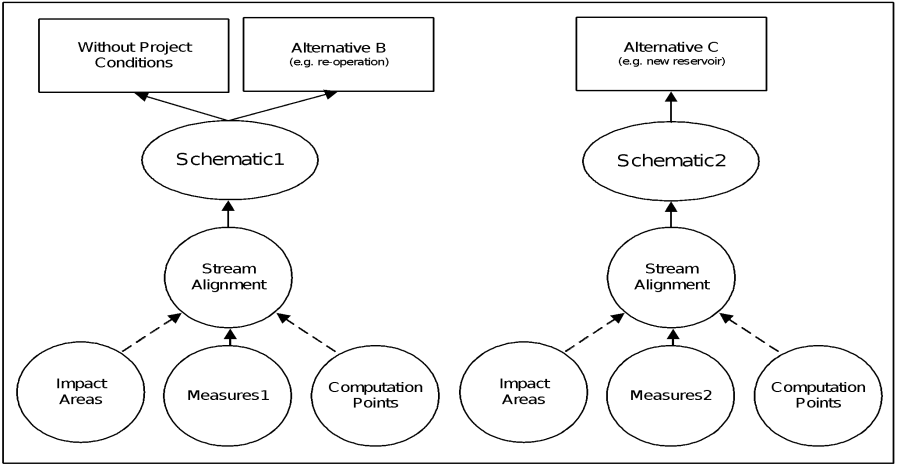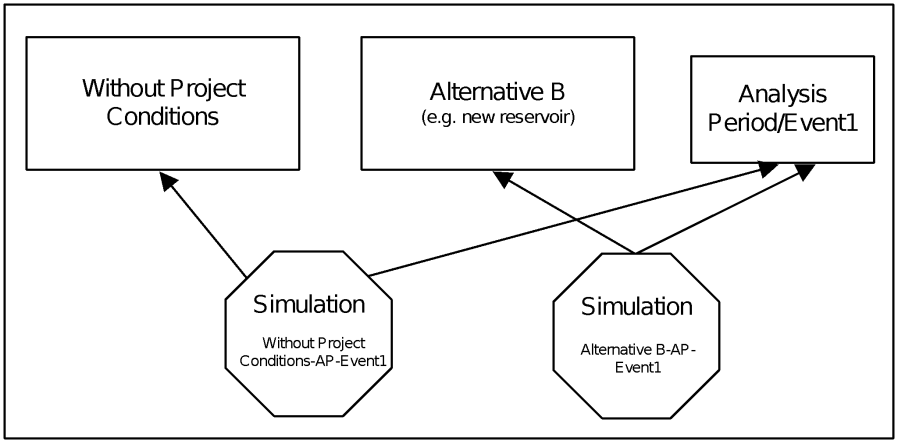Important Terminology
Several important terms refer to key components within HEC-WAT. Users should become familiar with the following terms and definitions:
Alternative
An alternative is a representation of the physical and operational system, and groups a schematic with different structural and nonstructural measures, operations, and their representation within component models. When the user creates a new study they are given the option to create a default base alternative – Without Project Conditions. Additional alternatives could include some future condition which represents changes to land use, as well as alternatives representing differing reservoir operational schemes or flood damage reduction measures including nonstructural flood risk management measures.
Analysis Periods
Analysis periods define a time window that can be associated with an alternative. Analysis periods are required to create simulations, and an analysis period can only be paired once with each HEC-WAT alternative.
Application Programming Interface (API)
The plugin architecture relies on a set of Application Programming Interfaces (API). The plugin API is a defined set of interfaces that, if implemented by an external developer, provide the ability to interact with various aspects of the HEC-WAT computational sequence, add elements to the user interface, or provide pre- or post-processing tools.
Event
An event is a representation of a time window (which can be the whole analysis period, or part of an analysis period) that describes an occurrence of some sort of hydrologic response.
Model Alternative
A model alternative is a single configuration with a specific set of input and parameters. A second model alternative would be defined by a different configuration, different input, or different parameters.
Plugin
HEC-WAT leverages unique plugins specific to HEC-WAT and existing software to work together through a plugin architecture. The plugin architecture allows the individual pieces of software to integrate without requiring special code in HEC-WAT to support the individual pieces of software. The plugin architecture allows users to import existing models (and model alternatives) or build individual models and associated model alternatives directly in an HEC-WAT study.
Realization
A realization is a unit of an HEC-WAT/FRA compute that represents a single *outcome* of the uncertain variables (those variables with knowledge, or epistemic, uncertainty). A single realization includes enough events to capture the range and likelihohood of variables with natural variability (randomness, or alleatory uncertainty).
Schematic
A schematic is a physical representation of a watershed boundary, stream alignment, and the geospatial components of measures to be modeled. The schematic also provides a common starting point for construction of compatible model configurations. A common schematic assures the naming convention, measure identification, and location for the study are consistent throughout the modeling disciplines. Additional schematics can be created and are useful if the HEC-WAT study has other alternatives with differences, such as an additional project in the study area.
For the example provided in the conceptual diagram of Schematic 1 and Schematic 2, the difference between the schematics is Measures 1 and Measures 2, respectfully. The conceptual diagram also illustrates that the schematic is a necessary component of an HEC-WAT alternative.

Simulation
A simulation is a combination of an analysis period associated with an alternative. A simulation is used to compute results across the model alternatives of the plugins in the program order for a given time window specified by the analysis period.
The conceptual diagram of the relationship between HEC-WAT alternatives and analysis periods to form simulations illustrates that the same analysis period can be used for two or more simulations when the simulations are in different HEC-WAT alternatives.

Study
In the HEC-WAT a study is a combination of data, models, and events required to analyze a specific geographic area.